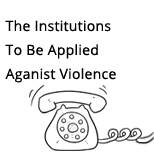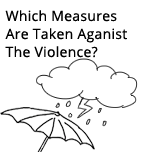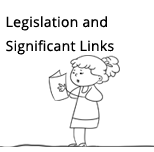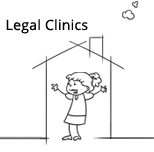“Law Clinic” is a concept that is borrowed from the medical sciences and reflects that the clinical practices in medicine can be also used for the legal studies and practices. The first studies in this field were put into practice in USA in 1960s and then began to be practiced in the legal education in the European countries. The main purpose of the practice is to provide the society which can’t benefit enough from the legal services because of the various reasons with utilizing the law for solving the problems regarding their own life or following their works and therefore, to support the society. The practice (like spending their last years of the students of the faculty of medicine in the hospitals) is carried out by the students of faculty of law. In this respect, the practice has two aspects; on the one hand, the students of faculty of law learn how the abstract informations in the courses are put into practice for the concrete problems, on the other hand, transfer the legal information to the persons whose opportunity for retaining a lawyer and accessing to the legal information is restricted because of social and economical conditions and guide them.
The legal clinics develop as an applied education model for the students in the faculty of law and also includes the legal aid services that are provided free of charge. While the traditional law teaching focuses on the theoretical content of the law, the clinical education enables the students to acquire skills to be needed in practice and teaches the morals that the jurists need to have.
This model provides the students of the faculty of law with the opportunity to get experience and strengthens the access to the justice for the people that need a legal information and support.
With the legal clinics that are a teaching method which the students of faculty of law acquire the necessary skills for putting the concepts and rules learned theoretically in the school into practice, the students understand the functionality of the rule, concept and institutions that are learned theoretically.
The clinical studies were introduced to the legal literature for the first time in the United States of America and the first studies began here. Prof.George Wythe, the first person appointed to the status of law professor in 1799 in the United States of America, began by adding the virtual hearing and virtual legislation sessions to his courses. But then his law teaching changed into the theoretical approach.
Theory and doctrin became a keystone of law teaching together with the proliferation of the faculties of law and acquiring academic qualification of the law teaching and it wasn’t tried for practicing the theory for the real problems. It was gradually seen that the theoretical law teaching was inadequate for enabling the students to develop the applicable skills.
In 1917, William V.Rowe, one of the lawyers of New York bar association, pointed that the law teaching needs more clinic education like Medicine teaching and the concrete, real cases need to be discussed. According to Rowe, the purpose of the clinical courses is not only to provide an application oriented education but also teach that the one duty of the law is to provide the best service for the poor and the people who don’t get access to the justice. In the clinical studies, it was specified that it is necessary to enable the students to learn and adopt the subjects of dignity, civic duty, social solidarity and social service.
Tending to the clinical legal education continued at the first half of XX. Century in the United States of America. However, the first clinical studies began under the sponsorship of Ford Foundation in 1960. The Ford Foundation funded to the faculty to provide the poor people with the law service by means of the legal clinics. The contributions of the foundation and the law faculties’ willingness to respond to the requests for social justice made the clinical education earn a respectful space in the programs of the faculties.
In the end of XX. Century, the clinical law education became a vital part of the law teaching and still continued by increasing in significance in the law teaching.
Due to the legal clinics, the students learn experimentally by going beyond the classical legal education and therefore it is enabled the students of the faculty of law to participate in the learning process more proactively. In notably the developing countries, the legal clinics serve the purpose to facilitate the access to justice of the poor and fragile parts of the society. According to the mass in the objective of this purpose and the provision of the legal service needed, the legal clinics are structured in the different forms.
1.Legal Clinic ( The Real Clinic- Real Client Clinic)
The persons needing the legal aid apply to these clinics and the students of law aid the people applying to the clinic in company with the trainer and/or the senior consultant. The legal clinic is functioning like a real law office administered by a lecturer working as a lawyer or a lawyer.
The legal clinics have differences about their practices in terms of subjects of activity and forms of activity from the country to the country, from the city to the city and from the university to the university because of the different needs, opportunities and the changing laws.
Although some legal clinics function in every area of the law, some clinics are working by focusing on a certain subject. The students either help the lawyers employed in the clinic in the process of filing and conducting a lawsuit or represent the applicant in person pursuant to the current legislation.
2.Simulation
In these practices, the students tranfer their information into the practice by means of the various simulations. The students try to solve a certain legal problem by taking roles such as lawyer, judge, prosecutor, witness. The virtual hearing or virtual judgement are the most common forms. Simulation is the oldest method of the clinical law education.
3.Clinic Externship
In this practice, the students participate in the activities for solving the legal problems in a court, a law office, an administrative organization or a non-governmental organization.
4.The Street Law Clinics ( Law in the Daily Life, Law for Everybody, Legal Literacy)
It occurs in a way to help the persons needing the legal aid by the students.
The fact that the people could use their rights is possible by learning their rights.
Although the law education is conducted by mainly the lecture method in the faculties, the scientific researchs show that this method is the least effective method in the transfer of the information
The retention rate of the information:
- Listening 5%
- Reading 10%
- Seeing 20%
- Discussing 50%
- Simulation 75%
- Teaching ( Transfering the things learned) 90%
Therefore, the students use the interactive teaching methods in their activities.
5. Problem Based Learning
By means of this method, it is the main purpose to concretize the lectures and courses by the cases and the events and enable the students to practice these lectures on these concretisations.
The most important point distinguishing this learning method from the the classical practical studies used commonly in our faculty is that this practice is conducted as an elective course and although the subjects to be discussed within the scope of the clinic courses are chosen, it is paid attention that the event includes the subjects concerned with more than one laws.
The clinical law education plays a big role in overcoming economic and social inequalities in the society. By providing the legal support for the people having financial difficulties, the students of law will find an opportunity to learn the situations of the disadvantaged groups at first hand and through experience by means of the settlement of the legal problems of the just clients. The law systems throughout the world do studies to support the access to justice of the economically disadvantaged groups.
“The development of the legal clinic methods” under the 8. purpose titled “To Improve Access to Justice” has been determined as a different objective in the text created within the scope of updating of the Judicial Reform Strategy drafted within the process of EU by the Ministry of Justice.
The legal clinical practices in the world are based on the point to contribute to and support the settlement of the legal problems of the disadvantaged (vulnerable) groups that don’t benefit from the justice services enough. However, it is targeted to implement the education and social responsibility policies by the aforementioned practices; the students whose education is continuing in the faculties of law provide the legal counselling/aid opportunity for the disadvanted groups under the control of the faculty. Therefore, the needs of the groups that lack the legal aid are met, on the other hand, it is targeted to contribute to primarily the students of law and all society by means of a permanent and usable legal education.
To do information and awareness activities and collaborate with the universities and bars in order to fulfill the aforementioned objective are thought as the specified strategies.
 , clicking Control Panel, clicking Network and Internet, and then clicking Internet Options.
, clicking Control Panel, clicking Network and Internet, and then clicking Internet Options. and then clicking Internet Explorer.
and then clicking Internet Explorer.






